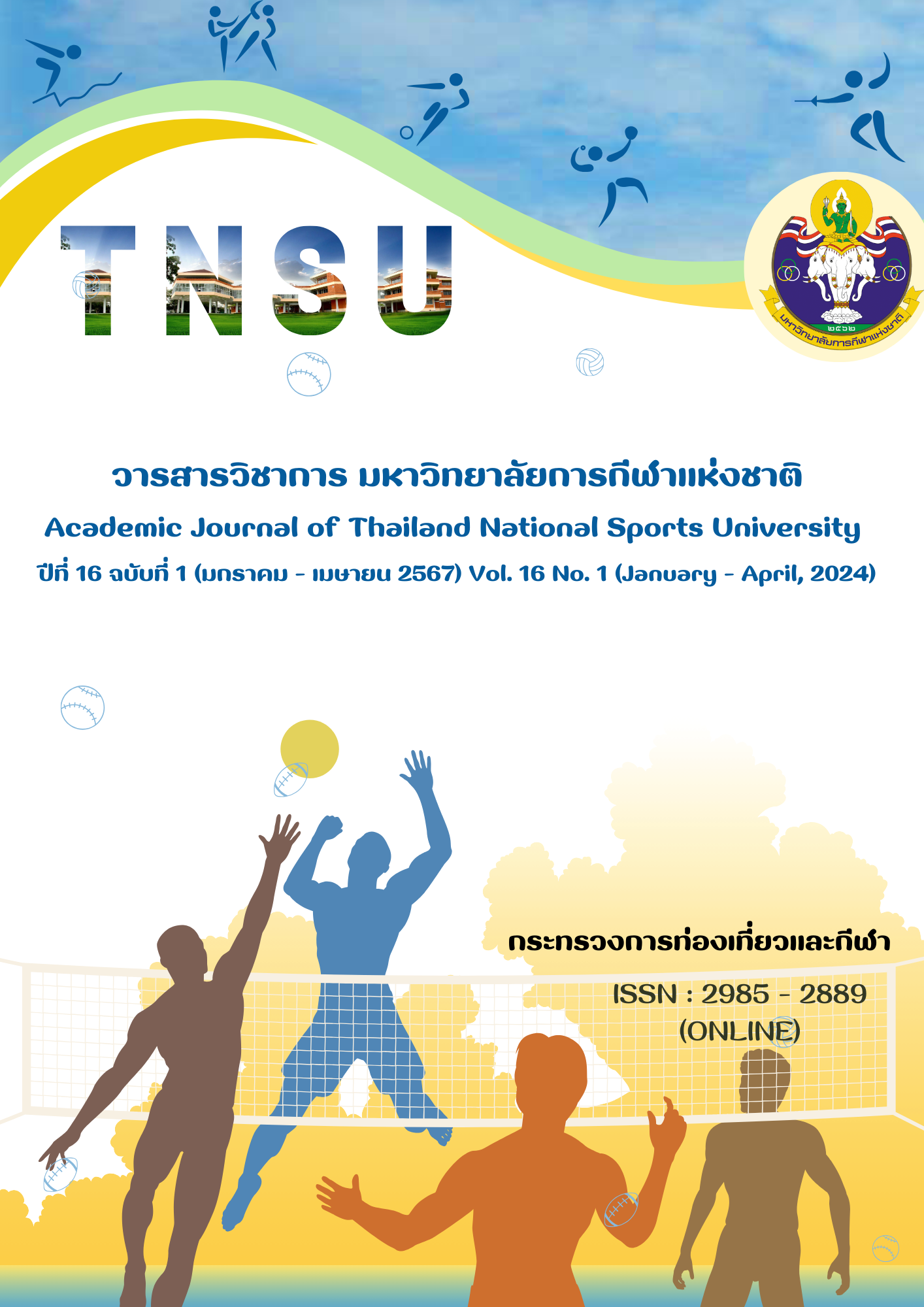SPORT ADVENTURE MODEL FOR SUSTAINABLE GREEN TOURISM
Main Article Content
Abstract
The objectives of this research were to 1) observe the potential of sport adventure model for sustainable green tourism, 2) develop sport adventure model for sustainable green tourism, and 3) study the efficient relationship of sport adventure model for sustainable green tourism. The potential survey interview form was used to interview 3 government executives, 3 academics, 3 tour operators, 3 adventure tour guides and 3 community representatives, totaling 15 people. The model was drafted and developed with an assessment form. The quality of the equipment was reviews by 3 experts. IOC = 0.84, Data were collected from 40 experts and was studied the relationship effectiveness of sport adventure model for sustainable green tourism. Data were analyzed using basic statistics. With the program G* Power, a sample of 400 people was collected with questionnaire for all 7 aspects of 35 items, checking the quality of the tools with 3 experts, IOC = 0.81 and the confidence value of the questionnaire (Try out) = 0.89. Data analysis, It average analysis standard deviation statistical difference by t-test and (F-test), correlation by simple correlation (Simple Correlation) and regression analysis (Regression Analysis) with statistical significance .05. The findings were found that the 7 aspects of the sustainable green tourism sport adventure model when used to develop the overall model had a high level of opinions ( = 4.23, S.D. = 0.63) and the green activities (Green Activity) has a high level of opinions (
= 4.27, S.D. = 0.71), followed by Green Service with a high level of opinions (
= 4.24, S.D. = 0.69) and social responsibility. The environment (Green Plus) had a high level of opinions. (
= 4.23, S.D. = 0.56) Green heart was at a high level (R = .748), 56.00 percent predictable, green travel patterns were at a high level (R = .829), 68.70 percent predictable, and green tourist attractions were at a high level (R = .857), 73.50 percent predictable, green activities were at a high level (R = .839), 70.40 percent predicted, community green was at a high level (R = .820), 67.20 percent predicted, and green services were at a high level (R = .825), 68.10 percent predictable and social and environmental responsibility at a high level (R = .841), 70.70 percent predictable.
Article Details

This work is licensed under a Creative Commons Attribution-NonCommercial-NoDerivatives 4.0 International License.
The published article is a copyright of the Academic Journal of Thailand National Sports University. The passage appeared in each article in this academic journal is a perspective of each author which is not related to the journal. Each author is required to be responsible for all components of his/her own article. If there are any mistakes, each author must be responsible for those mistakes on his/her own.
References
Aree Tirasatayapitak, & Chainan Chaiyasen. (2013). Eco - adventure hybrid tourism and tourism sustainability: Lessons from Song Phraek Wildlife Conservation Village. Silpakorn University Journal, 33(2), 167 - 185.
Department of Tourism (2018). National tourism development plan 2017 - 2021. Bangkok: Department of Tourism. Ministry of Tourism and Sports.
Kanta Komolachun. (2020). In selecting the use of eco - friendly hotels in Singapore (Master’s thesis), Mahidol University.
Krabi Municipality (2017). Office of civil and town planning. Krabi: Krabi Town Municipality Krabi Province.
Krabi Provincial Office (2021). Krabi Province strategic plan 2016 - 2017. Retrieved from http://krabi.thailocallink.com
Nastasi, B. K., & Schensul, S. L. (2005). Contributions of qualitative research to the validity of intervention research. Journal of School Psychology, 43(3), 177 - 195.
Office of the Constitutional Court. (2021). Constitution of the Kingdom of Thailand B.E. 2560 (4th ed.). Bangkok: Office of the Constitutional Court.
Office of the Higher Education Commission. (2021). The 15 - Year long range plan on higher education, No. 2 (2008 - 2022). Retrieved from http://qasp.tu.ac.th
Office of the National Economic and Social Development Board. (2017). National Economic and social development plan 2017 - 2021 (12th ed.). Bangkok: Office of the Prime Minister.
Patcharasorn Kanitthasoonthorn. (2016). A study of green tourism demand of residents in Bangkok (Master’s thesis), Thammasat University.
Phutinat Supaporn (2015). Perception of the image of social responsibility activities that affect loyalty to Sangsom Co., Ltd. of residents in Hom Kret Sub - district, Sampran District, Nakhon Pathom Province (Master’s thesis), Silpakorn University.
Siripat Chodchuang, Nontipak Pianroj, Nattamon Ratcharak, & Weerasak Kongrithi. (2018). 7 greens attitudes affecting tourism image perceptions of tourists in Koh Samui. Faculty of Liberal Arts and Management Sciences, Prince of Songkhla University.
Susaraporn Tanglam. (2016). Guidelines for the development of bicycle tour routes for tourism. Green Heart (Bike for Green Heart), Kasetsart University Kamphaeng Saen Campus, (pp. 279 - 280). Meeting National Academic Kasetsart University 13th Kamphaeng Saen Campus. 8 - 9 December 2016. Kasetsart University Kamphaeng Saen Campus.
Thailand National Sports University. (2019). Thailand National Sports University. Bangkok: Ministry of Tourism and Sports.
Thanadet Kiatlerttam. (2015). Memorable experiences of teenage tourists toward green activities in the lower northern region a case study of Ramkhamhaeng National Park (Khao Luang), Khiri Mat District, Sukhothai Province (Master’s thesis), Naresuan University.
Tourism Authority of Thailand. (2021). 7 Greens concept: Environmentally friendly tourism. Retrieved from http://7greens.tourismthailand
Travel articles. (2021). Thai tourism reform guidelines (2017). Retrieved from http://www.tatreviewmagazine.com
Faul, F., Erdfelder, E., Lang, A. G., & Buchner, A. (2007). G*Power 3: A flexible statistical power analysis program for the social, behavioral, and biomedical sciences. Behavior Research Methods, 39, 175 - 191. Retrieved from http://dx.doi.org/10.3758/BF03193146


